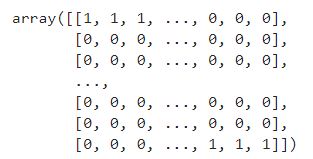神经网络学习
题目:
对于这个练习,我们将再次处理手写数字数据集。这次使用反向传播的前馈神经网络,自动学习神经网络的参数。这部分和ex3里是一样的,5000张20*20像素的手写数字数据集,以及对应的数字(1-9,0对应10)
import matplotlib.pyplot as plt
import numpy as np
import scipy.io as sio
import matplotlib
import scipy.optimize as opt
from sklearn.metrics import classification_report#这个包是评价报告
def load_data(path, transpose=True):
data = sio.loadmat(path)
y = data.get('y') # (5000,1)
y = y.reshape(y.shape[0]) # make it back to column vector
X = data.get('X') # (5000,400)
if transpose:
# for this dataset, you need a transpose to get the orientation right
X = np.array([im.reshape((20, 20)).T for im in X])
# and I flat the image again to preserve the vector presentation
X = np.array([im.reshape(400) for im in X])
return X, y
X, y = load_data('ex3data1.mat')
print(X.shape)
print(y.shape)
(5000, 400)
(5000,)
def plot_an_image(image):
# """
# image : (400,)
# """
fig, ax = plt.subplots(figsize=(1, 1))
ax.matshow(image.reshape((20, 20)), cmap=matplotlib.cm.binary)
plt.xticks(np.array([])) # just get rid of ticks
plt.yticks(np.array([]))
#绘图函数
pick_one = np.random.randint(0, 5000)
plot_an_image(X[pick_one, :])
plt.show()
print('this should be {}'.format(y[pick_one]))

def plot_100_image(X):
""" sample 100 image and show them
assume the image is square
X : (5000, 400)
"""
size = int(np.sqrt(X.shape[1]))
# sample 100 image, reshape, reorg it
sample_idx = np.random.choice(np.arange(X.shape[0]), 100) # 100*400
sample_images = X[sample_idx, :]
fig, ax_array = plt.subplots(nrows=10, ncols=10, sharey=True, sharex=True, figsize=(8, 8))
for r in range(10):
for c in range(10):
ax_array[r, c].matshow(sample_images[10 * r + c].reshape((size, size)),
cmap=matplotlib.cm.binary)
plt.xticks(np.array([]))
plt.yticks(np.array([]))
#绘图函数,画100张图片
plot_100_image(X)
plt.show()

raw_X, raw_y = load_data('ex3data1.mat')
print(raw_X.shape)
print(raw_y.shape)
(5000, 400)
(5000,)
准备数据
# add intercept=1 for x0
X = np.insert(raw_X, 0, values=np.ones(raw_X.shape[0]), axis=1)#插入了第一列(全部为1)
X.shape
(5000, 401)
# y have 10 categories here. 1..10, they represent digit 0 as category 10 because matlab index start at 1
# I'll ditit 0, index 0 again
y_matrix = []
for k in range(1, 11):
y_matrix.append((raw_y == k).astype(int)) # 见配图 "向量化标签.png"
# last one is k==10, it's digit 0, bring it to the first position,最后一列k=10,都是0,把最后一列放到第一列
y_matrix = [y_matrix[-1]] + y_matrix[:-1]
y = np.array(y_matrix)
y.shape
# 扩展 5000*1 到 5000*10
# 比如 y=10 -> [0, 0, 0, 0, 0, 0, 0, 0, 0, 1]: ndarray
# """
(10, 5000)
y

train 1 model(训练一维模型)
def cost(theta, X, y):
''' cost fn is -l(theta) for you to minimize'''
return np.mean(-y * np.log(sigmoid(X @ theta)) - (1 - y) * np.log(1 - sigmoid(X @ theta)))
def regularized_cost(theta, X, y, l=1):
'''you don't penalize theta_0'''
theta_j1_to_n = theta[1:]
regularized_term = (l / (2 * len(X))) * np.power(theta_j1_to_n, 2).sum()
return cost(theta, X, y) + regularized_term
def regularized_gradient(theta, X, y, l=1):
'''still, leave theta_0 alone'''
theta_j1_to_n = theta[1:]
regularized_theta = (l / len(X)) * theta_j1_to_n
# by doing this, no offset is on theta_0
regularized_term = np.concatenate([np.array([0]), regularized_theta])
return gradient(theta, X, y) + regularized_term
def sigmoid(z):
return 1 / (1 + np.exp(-z))
def gradient(theta, X, y):
'''just 1 batch gradient'''
return (1 / len(X)) * X.T @ (sigmoid(X @ theta) - y)
def logistic_regression(X, y, l=1):
"""generalized logistic regression
args:
X: feature matrix, (m, n+1) # with incercept x0=1
y: target vector, (m, )
l: lambda constant for regularization
return: trained parameters
"""
# init theta
theta = np.zeros(X.shape[1])
# train it
res = opt.minimize(fun=regularized_cost,
x0=theta,
args=(X, y, l),
method='TNC',
jac=regularized_gradient,
options={'disp': True})
# get trained parameters
final_theta = res.x
return final_theta
def predict(x, theta):
prob = sigmoid(x @ theta)
return (prob >= 0.5).astype(int)
t0 = logistic_regression(X, y[0])
print(t0.shape)
y_pred = predict(X, t0)
print('Accuracy={}'.format(np.mean(y[0] == y_pred)))
(401,)
Accuracy=0.9974
train k model(训练k维模型)
k_theta = np.array([logistic_regression(X, y[k]) for k in range(10)])
print(k_theta.shape)
(10, 401)
进行预测

prob_matrix = sigmoid(X @ k_theta.T)
np.set_printoptions(suppress=True)
prob_matrix

y_pred = np.argmax(prob_matrix, axis=1)#返回沿轴axis最大值的索引,axis=1代表行
y_pred
array([0, 0, 0, …, 9, 9, 7], dtype=int64)
y_answer = raw_y.copy()
y_answer[y_answer==10] = 0
print(classification_report(y_answer, y_pred))

神经网络模型图示

def load_weight(path):
data = sio.loadmat(path)
return data['Theta1'], data['Theta2']
theta1, theta2 = load_weight('ex3weights.mat')
theta1.shape, theta2.shape
((25, 401), (10, 26))
因此在数据加载函数中,原始数据做了转置,然而,转置的数据与给定的参数不兼容,因为这些参数是由原始数据训练的。 所以为了应用给定的参数,我需要使用原始数据(不转置)
X, y = load_data('ex3data1.mat',transpose=False)
X = np.insert(X, 0, values=np.ones(X.shape[0]), axis=1) # intercept
X.shape, y.shape
((5000, 401), (5000,))
feed forward prediction(前馈预测)
a1 = X
z2 = a1 @ theta1.T # (5000, 401) @ (25,401).T = (5000, 25)
z2.shape
z2 = np.insert(z2, 0, values=np.ones(z2.shape[0]), axis=1)
a2 = sigmoid(z2)
a2.shape
(5000, 26)
z3 = a2 @ theta2.T
z3.shape
a3 = sigmoid(z3)
a3

y_pred = np.argmax(a3, axis=1) + 1 # numpy is 0 base index, +1 for matlab convention,返回沿轴axis最大值的索引,axis=1代表行
y_pred.shape
(5000,)
准确率
虽然人工神经网络是非常强大的模型,但训练数据的准确性并不能完美预测实际数据,在这里很容易过拟合。
print(classification_report(y, y_pred))























 7038
7038











 被折叠的 条评论
为什么被折叠?
被折叠的 条评论
为什么被折叠?








